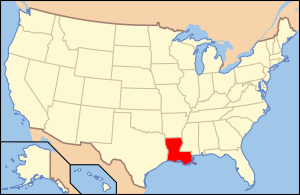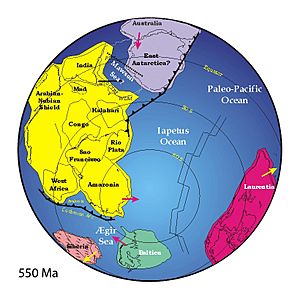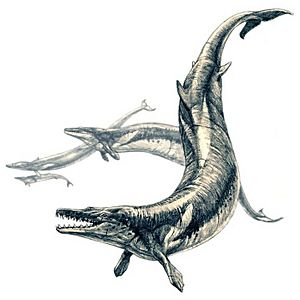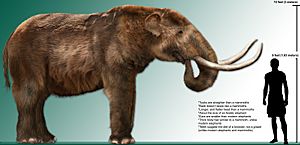Paleontology in Louisiana facts for kids

Paleontology in Louisiana is all about studying fossils found in or near Louisiana. Fossils are like clues from the past, showing us what life was like long ago. It's actually pretty hard to find fossils in Louisiana. This is because the weather here is often wet, which wears away rocks quickly. Also, thick plants cover the ground, hiding any fossil-rich layers. Plus, many rivers like the Mississippi have covered about half of Louisiana with new dirt, burying older fossil sites deep down.
Even with these challenges, scientists have learned a lot about Louisiana's ancient past. Millions of years ago, Louisiana was part of a huge landmass called Rodinia. This supercontinent later broke apart, and the area that would become Louisiana ended up underwater in the Iapetus Ocean. While some very old fossils have been found, they were moved here from other places much later. So, they don't tell us about the animals that lived in Louisiana during those super early times.
Louisiana stayed completely underwater until the middle of the Mississippian age. Then, the continents started to come back together, forming another supercontinent called Pangaea. When Pangaea broke apart, North America separated, and the Gulf of Mexico began to form. Louisiana's fossil story truly begins in the Late Cretaceous period. From this time, we find fossils of sharks and other sea creatures without backbones. After the Cretaceous, during the Age of Mammals, sea levels in Louisiana went up and down many times. When the land was covered by water, it was home to many different sea animals and even an early whale called Basilosaurus. We also find fossilized leaves and wood from plants that grew on land. Later, Louisiana became a coastal plain where mammals like camels and huge Ice Age animals like mastodons lived.
Long ago, Native Americans were the first people to try to understand Louisiana's fossils. For example, they thought mastodon bones belonged to a giant monster they called the "grandfather of the buffalo." Scientists like Georges Cuvier were interested in these findings as early as the 1700s, showing that people have been curious about Louisiana's fossils for a long time. The most famous fossil spot in the state is Montgomery Landing, located on the east side of the Red River of the South.
Contents
Louisiana's Ancient Past
From Supercontinents to Oceans

Scientists have discovered that the land Louisiana sits on has a very long and complicated history. During the late Proterozoic and early Cambrian times, a giant continent called Rodinia started to split apart. This created two main landmasses: Laurentia (which would become North America) and Gondwana (which included South America). Much of the land under Louisiana broke away from Laurentia and later joined what is now Argentina. The space between Laurentia and Gondwana, where Louisiana is today, was filled by the Iapetus Ocean.
Louisiana remained underwater from the early Cambrian to the middle Mississippian age. This ocean eventually became known as the Rheic Ocean. Most of the old ocean floor and islands from this time have been pulled deep into the Earth. We haven't found any local fossils from this period. However, some much younger Pliocene rocks in Louisiana contain fossils of ancient sea creatures like brachiopods, crinoids, and trilobites. These fossils actually came from Tennessee and were carried here by rivers.
Around this time, Laurentia and Gondwana began to move back together. When they collided, the remaining ocean floor was pushed northward, forming the Ouachita Mountains in Arkansas and Oklahoma. From the middle Pennsylvanian through the Triassic periods, the Louisiana area was completely dry land. It was part of the newly formed supercontinent called Pangaea.
The Gulf of Mexico Forms
During the Mesozoic Era, Pangaea started to break apart. This led to the separation of the North and South American continents, which created the Gulf of Mexico. At first, during the Triassic and early Jurassic periods, the land stretched and cracked, forming deep valleys that filled with red dirt and volcanic rocks. Later, in the middle to late Jurassic, the stretching of the Earth's crust created a large basin. This basin eventually connected to the Pacific Ocean and then the Atlantic Ocean. This stretching formed the northern edge of the Gulf of Mexico, where Louisiana is now.
In the Gulf of Mexico basin, a lot of thick salt and other mineral deposits formed in a shallow, very salty sea. By the end of the early Cretaceous period, the Gulf of Mexico basin had taken on its modern shape. We don't find any rocks older than the Late Cretaceous at the surface in Louisiana. This means that Louisiana's local fossil record begins in the Late Cretaceous.
Life in the Cretaceous Seas
During the Cretaceous period, Louisiana was covered by shallow seawater. This sea was home to many different sea creatures, including sharks and animals without backbones. Their remains have been found in Bienville Parish. The rocks containing these Cretaceous fossils are only seen in small areas in northwest Louisiana. They are found directly over places where salt has pushed up from deep underground. Otherwise, Cretaceous rocks are buried very deep under younger sediments, so their fossils are hard to reach. Because of this, we don't know if dinosaurs lived in Louisiana.
Cenozoic Era: Whales, Plants, and Mammals

Since the start of the Cenozoic Era, the shoreline of the Gulf of Mexico has moved back and forth across Louisiana. This happened because sea levels changed, new sediments built up, and the land slowly sank. A huge variety of life thrived in the ancient seas that covered Louisiana during the Paleogene period. These sea creatures included tiny animals called bryozoans, corals, and many kinds of molluscs like snails and clams.
In the late Eocene epoch, the Montgomery Landing area was home to over 50 different types of molluscs. Their remains were preserved in a special kind of muddy rock. About 150 different kinds of sea animal and fish fossils have been found in the Cane River Formation. The ancient whale Basilosaurus also lived in Louisiana and left behind fossils in the Yazoo clay. Many of these sea fossils from this time are found in different rock layers like the Midway, Wilcox, Claiborne, and Jackson groups.
These rock layers also tell us about the land environments. Even in the Paleogene, Louisiana had rivers and deltas. However, land fossils from this time are rare, so we don't know much about the animals that lived on land. Still, we have found some fossilized wood and leaves, which show us what plants grew here. Later, during the Oligocene epoch, Louisiana's sea life included corals, snails, and clams. Their fossils are found in the Vicksburg Group. The presence of ancient rivers and streams is shown by land sediments in the Catahoula Formation. Fossils from this ancient land environment are rare, but they include petrified wood.
During the Miocene epoch of the Neogene period, west-central Louisiana was a coastal plain. Animals that lived here were preserved in the rocks of the Fleming Group. Scientist Judith Schiebout found many different fossil animals, including many kinds of ancient vertebrates, in these rocks. In Louisiana, the Pliocene rocks are made of old river sand and gravel that have been weathered a lot. East of the Mississippi River, these rocks are called the Citronelle Formation, and west of it, they are called the Willis Formation. These rocks are actually younger than the fossils they contain! The fossils are remains of much older life from Tennessee. These Tennessee fossils were preserved in a hard rock called chert, which broke into gravel and was carried into Louisiana by the Tennessee River during the Neogene.
By the late Pleistocene epoch, the Mississippi River Valley had formed, and much of Louisiana was a coastal plain. Pleistocene sediments cover about 20% of Louisiana, mostly in the southern part. However, fossils from this age are still rare. Molluscs lived in the state's salty and brackish waters. Land snails were preserved in the loess (a type of wind-blown silt) that covers the high ground along the Mississippi River Valley. More exciting animals from Pleistocene Louisiana included huge creatures like camels and mastodons.
Fossil Discoveries in Louisiana
Native peoples in Louisiana had their own ideas about the giant mastodon fossils they found. They believed these were the bones of monsters, calling them the "grandfather of the buffalo." A French military officer named Fabri wrote about this in a letter to Georges Cuvier in 1748. In 1804, more large fossil bones were found on land belonging to the Opelousa people. The famous fossil site at Montgomery Landing was first written about in 1816.
It wasn't until 2004 that any dinosaur fossils were reported from Louisiana. The first find was a single tooth that had been washed out of older Cretaceous rocks and preserved in a younger Miocene fossil deposit near Fort Polk. The dinosaur it came from probably lived and died further north in Arkansas. Later, the tooth was washed out of the Cretaceous rocks and carried south by an ancient Sabine River to where it was found. The bones of large Ice Age animals, like mastodons, are sometimes found when people dig up dirt for roads or buildings.
Where to See Fossils
If you want to learn more about Louisiana's ancient past and see some fossils, you can visit these places:
- Lafayette Natural History Museum & Planetarium, Lafayette
- Louisiana Museum of Natural History, Baton Rouge
- Louisiana Art and Science Museum, Baton Rouge
Famous Fossil Sites
The most well-known fossil sites in Louisiana are Creola Bluff at Montgomery Landing in Grant Parish, Louisiana and the Cane River Site in Natchitoches Parish, Louisiana.
Montgomery Landing was once a bluff about 500 meters (1,640 feet) long and 14 meters (46 feet) high, located on the east side of the Red River of the South. It showed layers of rock from the Cockfield Formation, the Moodys Branch Formation, and the Tullos Member of the Yazoo Clay. In 1979, a large whale skeleton was discovered here.
The Moodys Branch Formation and Yazoo Clay were full of fossils. Over 100 species of invertebrate fossils and many kinds of vertebrate fossils were found, including one of the best Eocene whale skulls ever discovered. Sadly, changes to the Red River and construction have covered the lower parts of the site with dirt. The remaining parts are now covered by loose soil and plants. This means you can no longer find fossils at this site.
The Cane River Site is a small cut in the ground next to the road, made when Interstate Highway 49 was built near Natchitoches, Louisiana. It shows several feet of clay from the Cane River Formation, dating back about 44.5 to 46.5 million years ago. About 150 different kinds of marine invertebrate and vertebrate fossils have been found here. This site is slowly being worn away by weather and covered by plants.


